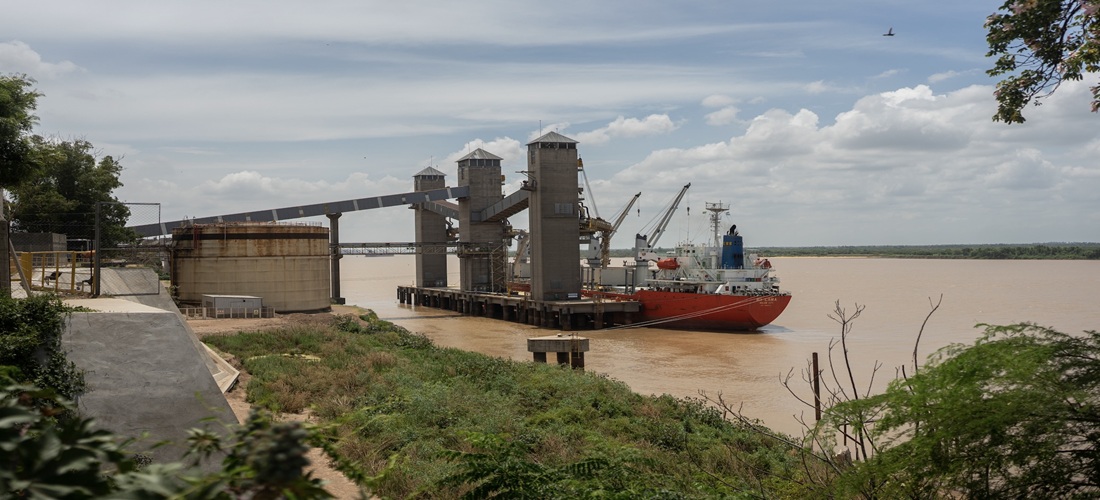
Argentine Agricultural Exports Stalled on the Paraná River
Feb, 14, 2025 Posted by Gabriel MalheirosWeek 202507
To understand Argentina’s struggle to be competitive, consider the plight of the Hansa Oslo. Freshly laden with a cargo of soybean oil on the banks of the Paraná River, the tanker set sail destined for India — only to come to a grinding halt eight miles downstream as its keel dug into a thick layer of silt.
The scene in November was all too familiar. Ships in the Paraná run aground roughly once a month, blocking the busy navigation channel for hours or even days at a time. The river snarl-ups are more than just a nuisance: They’re threatening the very viability of Argentina’s crop export industry, worth some $30 billion a year, as well as President Javier Milei’s vision to turn around its failed economy once and for all.
On Wednesday, that vision crashed into reality. Milei’s government canceled an auction to dredge the river deeper after receiving only one offer, and announced it will investigate Belgium’s DEME Group, which put up the only bid. Argentina alleged that DEME had potentially put pressure on other firms. The company denied wrongdoing hours later.
The failed auction poses another setback that stands to exacerbate concerns that time is running out for Argentina to overhaul a waterway that serves as its economic lifeline. Neighboring Brazil — where maritime infrastructure is already rapidly expanding — could build an insurmountable lead as Latin America’s agricultural powerhouse.
“Brazil is leaving us behind, and if we delay any further we’ll inevitably lose even more competitiveness,” said Antonio Sanchez, an Argentine shipping infrastructure expert at Panama-based consultancy firm Talasonomica.
Argentina’s gateway
The Paraná is Argentina’s gateway to global markets. Around 80% of all the country’s crops are loaded on its shores. But the shipping channel hasn’t been deepened since 2006 — even as global soy commerce has doubled in the same period.
The shallow waters mean that exporters in Argentina can’t load a typical Panamax ship as in rival Brazil. Instead, vessels sailing out of the Paraná have to anchor again at Atlantic ports to top up their cargoes, either at Argentina’s Bahía Blanca, or at Brazil’s Santos or Paranaguá. The detours cost hundreds of millions of dollars every year.
The efficiency of having a shipping route run right beside prime farm acreage spurred the world’s biggest agriculture traders, like Bunge Global SA, Cargill Inc., Louis Dreyfus Co. and Viterra Inc., to build a vast industrial complex for processing soybeans by the riverside city of Rosario. The development, which started in the 1990s, made Argentina the No. 1 exporter of soy meal, a livestock feed, and soy oil, used in food and biofuels.
Now, the country is trying to regain the logistics advantage that lured the traders in the first place.
“Taming the raging river to create the waterway was one of the greatest success stories in nautical history,” said Sergio Borelli, who navigated the Paraná for years as a ship pilot. “But within 10 to 15 years we realized that we had too many ships and a channel whose dimensions were too small for what we were aspiring to do. It needs to be deeper, wider, longer.”
New Dredging Deal
So it was initially a relief late last year when Milei’s government published the terms of a new dredging deal, including a key provision to deepen the waterway to 39 feet (11.9 meters) from 36 feet within five years, and the possibility of digging even deeper — though it’s unclear what impact excavating so much silt will have on cherished wetlands.
That squared with Milei’s vow to unleash the full potential of Argentina’s beleaguered farmers. The country depends on them for hard-currency revenue, which is vital to achieving sustained economic growth. But they have long been hampered by the government’s habit of taxing and meddling in exports — all while watching port expansions in Brazil keep pace with its remarkable crop boom.
Dredgers had until Wednesday to submit offers for the contract. In the recent past, China’s CCCC Shanghai Dredging Co. has also expressed interest, but Milei officials have excluded state-controlled entities from bidding.
The botched tender also came after the contract to maintain the waterway was allowed to expire a few years ago, which spawned administrative inefficiencies that shippers are paying for with recent hikes to river tolls.
Source: Yahoo Finance
-
Coffee
Mar, 13, 2019
0
Brazil’s coffee exports to reach a record 40m bags – Cecafé
-
Sep, 20, 2021
0
Porto Sudeste to conduct transshipment operations with vessels moored at Itaguaí
-
Meat
Aug, 01, 2021
0
Countries increase surveillance after African swine fever case reported in the Americas
-
Meat
Aug, 05, 2021
0
China resumes controls on frozen foods after Covid-19 outbreak

